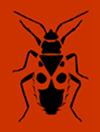Characterization of the immune induced antimicrobial peptide in Drosophila melanogaster and Drosophila ananassae
IF 1.2
3区 农林科学
Q2 Agricultural and Biological Sciences
引用次数: 1
Abstract
Insects can recognize invading pathogens and initiate an immune response. Among them, Drosophila has emerged as an invertebrate model for investigating innate immune responses in which antimicrobial peptides play a crucial role. In the present study, immune-induced antimicrobial peptides were characterized in D. melanogaster and D. ananassae using the agar well diffusion method, HPLC, SDS-PAGE and LC-MS/MS after infection with either S. aureus or E. coli. The HPLC revealed two and three differentially induced components, respectively, in D. melanogaster and D. ananassae fl ies infected with S. aureus and E. coli. The tricine SDS-PAGE analysis also revealed two and fi ve differentially induced proteins, respectively, in D. melanogaster and D. ananassae infected with E. coli. In E. coli infected fl ies, the ~6 kDa band was produced at higher level. Based on LCMS/MS and Mascot analysis, the peptide was identifi ed as a putative cecropin A-like peptide, and the data suggested that both species of Drosophila have exhibited a clear immune response. The fl ies were also able to discriminate between bacteria, as this putative cecropin A-like peptide was produced in fl ies infected with E. coli but not S. aureus. * Corresponding author; e-mail: knagarajv@gmail.com INTRODUCTION The fruit fl y, Drosophila melanogaster has innate immunity against invading microbes. This includes both cellular and humoral immune responses (Lye, 2018; Meghashree & Nagaraj, 2020). Antimicrobial peptides (AMPs) are an important component in the fi rst line of defence (Yuchen et al., 2019). AMPs are endogenous peptides with a molecular weight (MW) of ~2–22 kDa and they are released by the fat body (analogue of the liver) into haemolymph to clear off the microbial infections (Troha et al., 2019). The interactions of AMPs with Gram-positive and Gramnegative bacteria differ. The positively charged AMPs selectively interact with prokaryotes having a negatively charged bacterial cell-wall, including lipopolysaccharides (LPS) and phospholipids. Based on the available data (FlyBase), nine distinct classes of AMPs (23 members) are identifi ed in Drosophila (Thurmond et al., 2019). Among them, attacin, diptericin, cecropin and drosocin are produced in response to Gram-negative bacterial infections (Imd pathway), metchnikowin and defensin in response to a Gram-positive bacterial infection (Toll pathway) and drosomycin only in response to fungal infection (Sheehan et al., 2018). As fruit fl ies are genetically similar in the way they combat diseases as humans, they can be used to evaluate miEur. J. Entomol. 118: 355–363, 2021 doi: 10.14411/eje.2021.037黑腹果蝇和无尾果蝇免疫诱导抗菌肽的特性研究
昆虫可以识别入侵的病原体并启动免疫反应。其中,果蝇已成为研究先天免疫反应的无脊椎动物模型,其中抗菌肽发挥着至关重要的作用。在本研究中,在感染金黄色葡萄球菌或大肠杆菌后,使用琼脂扩散法、HPLC、SDS-PAGE和LC-MS/MS对黑腹果蝇和ananassae中免疫诱导的抗菌肽进行了表征。高效液相色谱法显示,在感染金黄色葡萄球菌和大肠杆菌的黑腹果蝇和阿氏果蝇中,分别有两种和三种不同诱导的成分。tricine SDS-PAGE分析还显示,在感染大肠杆菌的黑腹果蝇和ananassae中,分别有两种和五种不同诱导的蛋白质。在大肠杆菌感染的flies中,产生了较高水平的~6kDa带。基于LCMS/MS和Mascot分析,该肽被鉴定为一种假定的cecropin a样肽,数据表明这两种果蝇都表现出明显的免疫反应。flies还能够区分细菌,因为这种假定的盲肠素A样肽是在感染大肠杆菌而不是金黄色葡萄球菌的flies中产生的。*通讯作者;电子邮件:knagarajv@gmail.com简介果蝇的果实对入侵的微生物具有天生的免疫力。这包括细胞和体液免疫反应(Lye,2018;Meghashree和Nagaraj,2020)。抗菌肽是第一道防线的重要组成部分(Yuchen等人,2019)。AMP是分子量(MW)为~2-22kDa的内源性肽,它们由脂肪体(肝脏的类似物)释放到血淋巴中,以清除微生物感染(Troha等人,2019)。AMPs与革兰氏阳性菌和革兰氏阴性菌的相互作用不同。带正电的AMP选择性地与具有带负电的细菌细胞壁的原核生物相互作用,包括脂多糖(LPS)和磷脂。根据现有数据(FlyBase),在果蝇中鉴定出9类不同的AMP(23个成员)(Thurmond等人,2019)。其中,Attachin、Ditericin、cecropin和drosocin是对革兰氏阴性细菌感染(Imd途径)的反应产生的,Metchnikovin和防御素是对革兰氏阳性细菌感染(Toll途径)的响应产生的,而drosomycin仅对真菌感染的反应产生(Sheehan等人,2018)。由于果蝇在对抗疾病方面与人类基因相似,因此可以用来评估miEur。J.昆虫。118:355-3632021 doi:10.144411/eje.2021.037
本文章由计算机程序翻译,如有差异,请以英文原文为准。
求助全文
约1分钟内获得全文
求助全文
来源期刊
CiteScore
2.30
自引率
7.70%
发文量
43
审稿时长
6-12 weeks
期刊介绍:
EJE publishes original articles, reviews and points of view on all aspects of entomology. There are no restrictions on geographic region or taxon (Myriapoda, Chelicerata and terrestrial Crustacea included). Comprehensive studies and comparative/experimental approaches are preferred and the following types of manuscripts will usually be declined:
- Descriptive alpha-taxonomic studies unless the paper is markedly comprehensive/revisional taxonomically or regionally, and/or significantly improves our knowledge of comparative morphology, relationships or biogeography of the higher taxon concerned;
- Other purely or predominantly descriptive or enumerative papers [such as (ultra)structural and functional details, life tables, host records, distributional records and faunistic surveys, compiled checklists, etc.] unless they are exceptionally comprehensive or concern data or taxa of particular entomological (e.g., phylogenetic) interest;
- Papers evaluating the effect of chemicals (including pesticides, plant extracts, attractants or repellents, etc.), irradiation, pathogens, or dealing with other data of predominantly agro-economic impact without general entomological relevance.

 求助内容:
求助内容: 应助结果提醒方式:
应助结果提醒方式:


